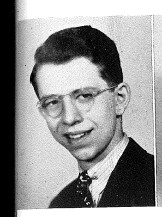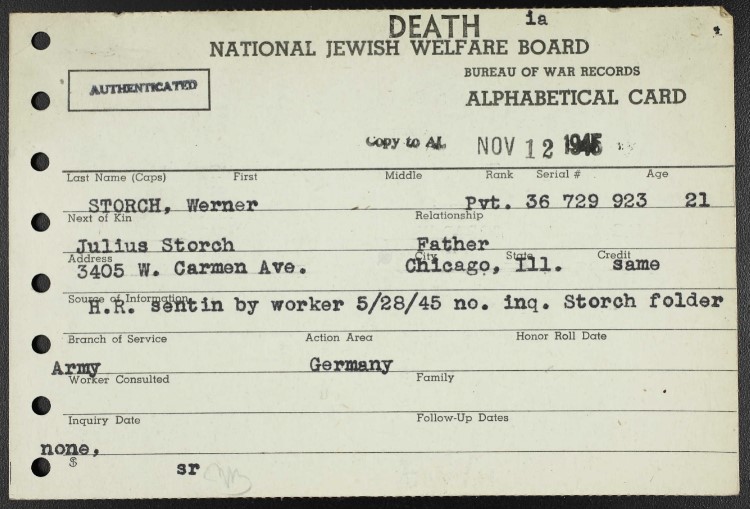Private Werner Storch

- Unit: 63rd Infantry Battalion, 11th Armored Division
- Service Number: 36729923
- Date of Birth: April 17, 1923
- Entered the Military: June 29, 1942
- Date of Death: April 12, 1945
- Hometown: Chicago, Illinois
- Place of Death: Suhl, Germany
- Award(s): Purple Heart
- Cemetery: Plot I, Row 13, Grave 4. Netherlands American Cemetery, Margraten, Netherlands
Mentored by Mrs. Meghan Thomas
Von Steuben High School
2019-2020
Early Life
On April 17, 1923, Werner Storch was born in Berlin, Germany. His family heritage was Polish, German, and Jewish. His mother, Elly, spent her days raising her son while Storch’s father, Julius, worked as a merchant. Werner was their only child. The Storch family eventually departed from Hamburg, Germany when Werner was only 11 years old. Traveling aboard the S.S. Washington, they docked in New York on April 24, 1934.
In the United States, the Storch family lived in Albany Park, a predominantly Jewish neighborhood, on the north side of Chicago, Illinois. Storch attended Von Steuben High School, where he won first prize for extemporaneous speech in 1941. A native German speaker, Storch learned English and grew to know his way around the language through writing. An article in the Chicago Tribune noted Storch was the editor-in-chief of the Von Steuben High School newspaper, the Von Steuben Journal.
Werner Storch was eventually drafted on June 29, 1942.



Homefront
Chicago was one of the biggest industrial suppliers for World War II as it had a great geographical vantage point; Chicago is located on Lake Michigan and supplies were easily transported and distributed through the Illinois & Michigan Canal. The United States’ entrance into World War II inspired many Chicagoans to support their country through military service or through wartime jobs. Chicagoans, both young and old, felt responsible for their country’s victory in the war; but they would only achieve victory with their active participation and support. Wartime production bolstered the American economy and led to prosperity and jobs for many.
Storch’s home of Albany Park faced new challenges. A wave of fear enveloped Albany Park as anti-Semitic sentiments took hold of the city. On June 18, 1939, just three months before the start of World War II, a giant Nazi rally took place on the corner of Irving Park and Narragansett Avenue, just two miles away from Albany Park. Chicago’s Nazi rally occurred during Hitler’s aggressive campaign to seize lands lost in 1919, just months after Czechoslovakia fell to Nazi occupation. Many Jewish families were scared for their families in Europe, and now feared for their safety in the United States, as their geographical “advantage” no longer protected them from growing racism and violence. This fear drove many young men to war to protect their families and themselves. Jewish Americans felt they had to serve to protect their liberty as a minority group. Many Jewish soldiers wore Stars of David as a reminder of their heritage and the reason they fought against the Nazi regime.
Military Experience
Private Werner Storch served as a member of the 11th Armored Division, 63rd Infantry Battalion. Nicknamed “thunderbolt,” their motto was J’avance, which means, “I advance” in French.
The 63rd Infantry Battalion sailed to England in September 1944. They then crossed the English Channel (La Manche) to France. The 63rd Infantry Battalion advanced around Europe for the next several months, capturing and protecting bridges and other points of interest.
In April 1945, the 63rd Infantry Battalion closed in on Nazi Germany. They pushed north into the small countryside towns south of Berlin. The 63rd Infantry Battalion patrolled the towns, keeping the enemy lines from advancing south, while engineers worked to rebuild bridges damaged from explosions.
Lieutenant Colonel John W. Brady wrote in the after action report that within the month of April, five men were killed, 16 were wounded and five were missing. Unfortunately, Werner was one of the five men who were killed. The exact details of his death are unknown.

Eulogy
During a conversation with Mike Nussbaum, a 1941 Von Steuben High School alumnus, he remembered fellow graduate Werner Storch’s German accent and his role as the school’s newspaper editor. This bit of knowledge allowed me to imagine Werner’s personality in high school, and I felt lucky to know someone who knew him. Private Werner Storch was born in Berlin, Germany in 1923. When Werner was 11 years old, the Storch family departed from Hamburg, possibly seeking refuge in the United States from the growth of antisemitism in Europe.
Life in the U.S. brought new challenges and experiences for Werner. At only 18 years old, he had a gift and a passion for writing.
Eventually, he became Private Werner Storch of the 63rd Infantry Battalion of the 11th Armored Division. In April 1945, the men of the 63rd Infantry Battalion were closing in on Nazi Germany in the small countryside towns south of Berlin. The men patrolled the towns, pushing back the enemy forces stationed in the area. Lieutenant Colonel John W. Brady wrote in the after action report that within the month of April, five men were killed, 16 were wounded and five were missing. Unfortunately, Werner was one of the five men who were killed.
Storch was not able to see the final victory for the United States, but the people in Albany Park who knew him remembered their neighbor, their son, their classmate, their writer. Storch served his mission and selflessly gave his life to liberate his homes Germany and Chicago from antisemitism. I feel honored to have shared Werner’s story. Alav ha shalom. May he rest in peace.

Reflection
Operation Liberty was an unforgettable trip. I learned the struggles of a country that was subjected to the tyranny of Nazi Germany. The two most powerful locations on the trip were the Anne Frank House and the Netherlands American Cemetery. Both points of interests convey the giant loss suffered during World War II.
The Anne Frank house represents what people resort to when there is discrimination, prejudice, and oppression. The annex was left empty after the Germans raided it, and Otto Frank, Anne’s father, chose to leave it that way. I strongly agree with Otto Frank’s decision and believe that it shows how hate can hollow out what was once a warm inviting home.
At the Netherlands American Cemetery, I felt honored to be visiting thousands of heroes. The cemetery has 8,291 burials and 1,722 missing in action. I carefully spotted several Stars of David among the thousands of headstones. I felt overjoyed to have met my Silent Hero, Private Werner Storch; I was no longer just reading off a name but instead sanding his name on his engraved Star of David, which could be seen from several feet away. I was able to leave Private Storch a nice stone to show that I visited and paid my respects. The moment was very powerful and I am astonished that Private Storch’s ultimate sacrifice drew a personal connection between Private Storch and me; we both came from immigrant families who sought a better life. I want to make sure that Private Storch and other heroes like him are not forgotten and lost in history.
Bibliography
Primary Sources
“Dienstein.” Chicago Tribune. January 28, 1988. Newspapers.com.
Hamburg State Archives. Hamburg Passenger Lists, 1850-1934. Digital Images. ancestry.com.
Illinois. Cook County. 1940 U.S. Census. Digital Images. ancestry.com.
Jewish Serviceman Card. Alphabetical Master Cards, 1942–1947; Series VI, Card Files—Bureau of War Records, Master Index Cards, 1943–1947; National Jewish Welfare Board, Bureau of War Records, 1940–1969; I-52; boxes 273–362. New York, New York: American Jewish Historical Society, Center for Jewish History. ancestry.com.
Naturalization Records, U.S. District Court, Illinois, Chicago. Digital Images. ancestry.com.
Passenger Lists of Vessels Arriving at New York, New York, 1820-1897. Microfilm Publication M237, 675 rolls. NAI: 6256867. Records of the U.S. Customs Service, Record Group 36. National Archives and Records Administration. ancestry.com.
“World War II Draft Registration Cards, 1940–1947.” Digital Images. ancestry.com.
Secondary Sources
“The 11th Armored Division.” Holocaust Encyclopedia, United States Holocaust Memorial Museum. Accessed October 3, 2019. encyclopedia.ushmm.org/content/en/article/the-11th-armored-division.
“11th Armored Division,” U.S. Army Center of Military History. Accessed October 3, 2019. history.army.mil/documents/ETO-OB/11AD-ETO.htm.
“Southside Jewish Chicago,” Chicago Jewish Historical Society. Accessed October 3, 2019. www.chicagojewishhistory.org/past-events/south-side-jewish-chicago.aspx.
Steward, Hal D. Thunderbolt: The History Of The 11th Armored Division. Washington, D.C.: 11th Armored Division Association, 1948. archive.org/details/Thunderbolt11th.
“Virtual Jewish World: Chicago, Illinois,” The Jewish Virtual Library. Accessed October 3, 2019. www.jewishvirtuallibrary.org/chicago-2.
“Werner Storch.” American Battle Monuments Commission. Accessed February 11, 2020. abmc.gov/node/389151.
“Werner Storch.” Find a Grave. Updated August 15, 2015. Accessed October 3, 2019. www.findagrave.com/memorial/150792835/werner-storch.

